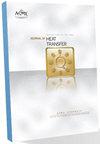Thermal Hydraulic Performance Of A Turbulent Wall Jet Flowing Over A Wavy Wall
IF 2.8
4区 工程技术
Q2 ENGINEERING, MECHANICAL
引用次数: 0
Abstract
The thermal and fluid flow characteristics have been studied numerically for the partial wavy wall. The partial wall is created by giving a segment of wall a wavy pattern from the leading edge followed by the plane wall; the wavy wall segment varies from 10% to 100% of the wall. The amplitude of wavy surface has also been varied from 0.2a to 0.8a with the interval of 0.2a, where ‘a’ is the nozzle height. The results of the present problem have been compared with the results of fully plane wall jet. The Reynolds number at the nozzle exit is constant, i.e. 15000 for all the cases in order to achieve fully turbulent jet. To solve this problem, low Reynolds number RNG model has been used. The results obtained from the present study show that the heat transfer rate remains almost same for 10% to 100 % wavy wall for 0.2a amplitude. In the case of amplitude 0.8a, the heat transfer rate is maximum for 30% wavy wall case; the heat transfer rate reduces further for higher wavy wall %. There is a 26.27% increment in heat transfer for the 30% wavy wall with 0.8a amplitude relative to the fully plane wall jet. The maximum increment in the thermal hydraulic performance (THP) of 5.3% is achieved for 70% wavy wall portion for 0.8a amplitude and it remains the same for further increase in the % of wavy wall.紊流壁面射流在波浪壁面上的热工性能
对部分波浪壁面的热特性和流体流动特性进行了数值研究。所述部分壁是通过使一段壁具有从前缘开始的波浪形图案,然后是所述平面壁而形成的;波浪形壁段占壁的10%到100%不等。波浪形表面的振幅也从0.2a变化到0.8a,间隔为0.2a,其中“a”为喷嘴高度。本文的计算结果与全平面壁面射流的计算结果进行了比较。为了实现完全的湍流射流,在所有情况下,喷管出口的雷诺数都是恒定的,即15000。为了解决这一问题,采用了低雷诺数RNG模型。研究结果表明,在0.2a振幅范围内,10% ~ 100%波浪壁面的换热率基本保持不变。振幅为0.8a时,30%波壁情况下换热率最大;波浪壁%越高,传热率越低。振幅为0.8a的30%波浪壁面的换热量比全平面壁面射流增加了26.27%。在振幅为0.8a时,70%波壁部分的热工性能(THP)增幅最大,为5.3%;进一步增加波壁部分的百分比,THP增幅保持不变。
本文章由计算机程序翻译,如有差异,请以英文原文为准。
求助全文
约1分钟内获得全文
求助全文
来源期刊
自引率
0.00%
发文量
182
审稿时长
4.7 months
期刊介绍:
Topical areas including, but not limited to: Biological heat and mass transfer; Combustion and reactive flows; Conduction; Electronic and photonic cooling; Evaporation, boiling, and condensation; Experimental techniques; Forced convection; Heat exchanger fundamentals; Heat transfer enhancement; Combined heat and mass transfer; Heat transfer in manufacturing; Jets, wakes, and impingement cooling; Melting and solidification; Microscale and nanoscale heat and mass transfer; Natural and mixed convection; Porous media; Radiative heat transfer; Thermal systems; Two-phase flow and heat transfer. Such topical areas may be seen in: Aerospace; The environment; Gas turbines; Biotechnology; Electronic and photonic processes and equipment; Energy systems, Fire and combustion, heat pipes, manufacturing and materials processing, low temperature and arctic region heat transfer; Refrigeration and air conditioning; Homeland security systems; Multi-phase processes; Microscale and nanoscale devices and processes.

 求助内容:
求助内容: 应助结果提醒方式:
应助结果提醒方式:


